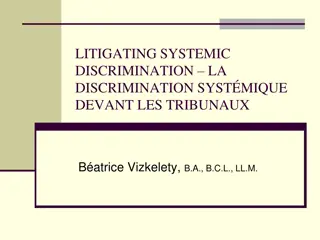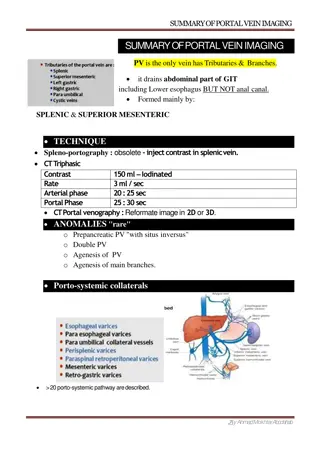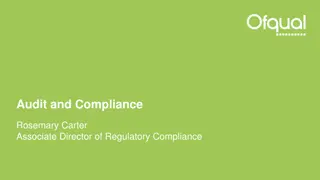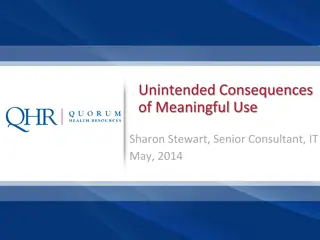Unintended Systemic Risk Consequences of Regulatory Compliance Study
This study by Barry Quinn, Barbara Casu, Sami Ben Nacuer, and Rym Ayadi explores the predictive relationship between international regulatory compliance, specifically Basel Core Principles, and systemic risk in banks. Results show varying impacts on systemic risk based on supervisors' and banks' actions regarding compliance.
Download Presentation

Please find below an Image/Link to download the presentation.
The content on the website is provided AS IS for your information and personal use only. It may not be sold, licensed, or shared on other websites without obtaining consent from the author.If you encounter any issues during the download, it is possible that the publisher has removed the file from their server.
You are allowed to download the files provided on this website for personal or commercial use, subject to the condition that they are used lawfully. All files are the property of their respective owners.
The content on the website is provided AS IS for your information and personal use only. It may not be sold, licensed, or shared on other websites without obtaining consent from the author.
E N D
Presentation Transcript
1/14 Unintended Systemic Risk Consequences of Regulatory Compliance Barry Quinn (Queen s University Belfast) Barbara Casu (Cass Business School) Sami Ben Nacuer (IMF) Rym Ayadi (HEC Montreal)
2/14 Today Motivation Contribution Key Finding Our Empirical Design Key Findings and Discussion Concluding remarks
3/14 Motivation In 2012 a comprehensive review of the Basel Committee on Banking Supervision s Core principles for effective banking supervision(BCPs)sought to: 1. More effectively deal with Systemically Important Banks 2. Focus on systemic risk by applying a macro perspective to the microprudential supervision. 3. Focus on reducing both the probability and impact of a bank failure. Horvath and Wagner (2017) argue that the systemic effect of countercyclical capital requirements is ambiguous. Danielsson (2002) critiqued Basel II capital policies as suffering from the fallacy of composition. Risk is endogenous to the system while nonetheless appearing exogenous to individual firm.
4/14 Contribution We contribute to the on-going policy debate by assessing whether international regulatory compliance predicts systemic risk. We focus specifically on the adoption of international capital standards and the Basel Core Principles for Effective Bank Supervision (BCP). We further disaggregate the systemic risk consequence of regulatory compliance into: 1. Supervisors actions. 2. Banks actions. We evaluate how compliance with BCP predicts systemic risk of 993 publicly listed banks from North America and Europe over the period 1999-2015.
5/14 Key Findings We find a positive predictive relationship between BCP compliance and systemic risk. Encouragingly, what supervisors are doing reduces systemic risk. Surprisingly, what supervisors want banks to do increases systemic risk. The latter findings is driven by capital adequacy compliance.
6/14 Our Empirical Design We create annual aggregate % compliance scores and disaggregated scores for banks and supervisors actions for 25 country over the period 1999-2015. Systemic risk is measured using a time-varying version of Conditional Value at Risk introduced by Adrian and Brunnermeier (2016) The precedent sensitivity of systemic risk to BCP compliance is assessed using a dynamic Difference in Difference framework. ???+ ??,? ? ? $??????,? = ??+ ????,? ? + ?????,? ?+ ???,? ?+ ??? ?
7/14 Our Empirical Design Three systems are defined to estimate systemic risk and empirical test the above relationship 1. A system of systemically important banks 2. A system of North American banks 3. A system of European Banks Systemic risk is estimate weekly using all publicly listed financial institutions in each system for the longest possible period that reliable data is available; 1990- 2016. Systemic risk is then aggregated to the quarterly level and matched with firm characteristics and BCP scores. To control of the changing nature of our unbalanced panel over the period we use a portfolio sort as per Adrian and Brunnermeier (2008)
8/14 Sample Daily equity price data, and quarterly balance sheet data for period 1993-2015 are sourced from Bloomberg. The macroeconomic state variables are collected from Thomson Reuters Datastream. The principal variable of interest, BCP compliance, is derived from the IMF and World Bank Basel Core Financial Sector Assessment Program (FSAP) database. After a number of sanity filters we have an unbalanced panel of 993 banks over a 1719 week period Importantly this includes the publicly quoted global and domestic systemically important financial institutions identified by the FSB and EBA in the last three years.
9/14 Summary Statistics Systemically Important Banks European Banks North American Banks Variables Mean Std Dev Obs Mean Std Dev Obs Mean Std Dev Obs $CoVaRi95,t 1173.85 2250.78 4378 264.29 1276.09 7828 137.14 789.93 39509 $CoVaRi99,t 2320.44 4542.14 4378 370.18 1695.82 7828 290.92 1696.42 39509 VaRi95,t 45.52 24.12 4496 48.39 21.57 8273 26.8 14.8 40430 VaRi99,t 80.34 37.31 4496 76.62 25.56 8273 59.54 29.47 40430 Leverage % 92.76 3.15 4496 7.58 3.77 8273 10.45 7.41 40430 Size 1.10 0.19 4487 0.83 0.21 8184 0.63 0.24 40194 Maturity Mismatch % 13.66 11.40 4496 0.13 0.10 8273 0.05 0.07 40430 Boom 0.87 4.29 4496 1.02 3.68 8273 0.76 4.01 40430 Overall BCP % 12.59 7.74 318 18.97 9.41 879 5.26 0.02 2257 Supervisors BCP % 15.30 8.51 318 20.92 10.96 879 6.08 0.62 2257 Banks BCP % 17.92 7.85 318 19.8 11.4 879 18.59 2.64 2257 Capital Adequacy BCP % 23.14 7.29 318 24.02 8.02 879 20 0.1 2257 Credit Risk BCP % 23.08 7.23 318 27.52 9.70 879 21 0.1 2257 Concentration Risk BCP % 31.26 9.94 318 30.79 10.35 879 39.50 3.12 2257 Market Risk BCP % 25.85 11.11 318 29.35 12.03 879 21.50 9.37 2257 Liquidity Risk BCP % 29.12 9.98 318 26.17 9.64 879 38.58 5.13 2257 Operational Risk BCP % 23.90 9.66 318 31.17 13.94 879 19 0.2 2257 Note: The table reports statistics of the quarterly variables used in the $CoVaRused in the dynamic DiDregressions. The data spans 1990:Q1-2015:Q4 and covers 993 banks, 209 in Europe and 784 in North America. VaRiq,t is expressed in quarterly percent. $CoVaRiq,t is normalised by the cross sectional average of market equity each quarter and is expressed in quarterly basis points.
10/14 Systemically Important Banks 199 (20*9.93) bps of quarterly market equity losses at the original BCP scale Dependent variable: Panel A: $CoVaRi95,t 8.31*** (1.74) Panel B: $CoVaRi99,t 9.93*** (4.04) Overall BCP Supervisors BCP -1.22*** (0.47) 6.71*** (2.18) -7.36*** (1.09) 8.41*** (1.26) Banks BCP Other coefficients estimates redacted for exposition purposes Fixed Effects Observations R2 Adjusted R2 This table reports coefficients from difference in difference regression for $CoVaRi95,t on one year lag of the BCP variables, state variables, and bank characteristics in panel A and for $CoVaRi99,t in panel B. Each regression has a panel of firms. Newey-west standard errors allowing for up to five periods of autocorrelation are displayed in parentheses *p<0.1;**p<0.05;***p<0.01. Bank characteristic and state variable coefficients have been redacted for visual exposition. Yes 3,082 0.61 0.61 Yes 3,082 0.61 0.61 Yes 3,082 0.60 0.60 Yes 3,082 0.60 0.60
11/14 North American Banks 626 (20*31.28) bps of quarterly market equity losses at the original BCP scale Dependent variable: Panel A: $CoVaRi95,t 19.04** (8.63) Panel B: $CoVaRi99,t 31.28** (15.81) Overall BCP Supervisors BCP -45.28** (6.24) 53.10*** (20.18) -72.26*** (19.73) 131.15*** (49.85) Banks BCP Other coefficients estimates redacted for exposition purposes Fixed Effects Observations R2 Adjusted R2 Note: This table reports coefficients from difference in difference regression for $CoVaRi95,t on one year lag of the BCP variables, state variables, and bank characteristics in panel A and for $CoVaRi99,t in panel B. Each regression has a panel of firms. Newey-west standard errors allowing for up to five periods of autocorrelation are displayed in parentheses *p<0.1;**p<0.05;***p<0.01. Yes 34,876 0.25 0.25 Yes 34,876 0.25 0.25 Yes 34,876 0.24 0.24 Yes 34,876 0.24 0.24
12/14 European Banks 39 (20*1.97) bps of quarterly market equity losses at original BCP scale Dependent variable: Panel A: $CoVaRi95,t 1.32*** (0.25) Panel B: $CoVaRi99,t 1.97*** (.70) Overall BCP Supervisors BCP -0.62*** (0.20) 1.89*** (0.58) -0.40*** (0.17) 2.15*** (1.01) Banks BCP Other coefficients estimates redacted for exposition purposes Yes Yes 6,794 6,794 0.51 0.51 0.51 0.51 Note: This table reports coefficients from difference in difference regression for $CoVaRi95,t on one year lag of the BCP variables, state variables, and bank characteristics in panel A and for $CoVaRi99,t in panel B. Each regression has a panel of firms. Newey-west standard errors allowing for up to five periods of autocorrelation are displayed in parentheses *p<0.1;**p<0.05;***p<0.01. Fixed Effects Observations R2 Adjusted R2 Yes 6,794 0.54 0.53 Yes 6,794 0.54 0.53
13/14 Bank BCP principle level Analysis Panel A: SIBs Panel B: North American 1640 (20*82.60) bps of quarterly market equity losses at original BCP scale Panel C: European Banks $CoVaRi95, -13.38*** (4.46) 92.63*** (3.37) -11.24*** (3.87) -5.30 (4.28) -30.03** (3.65) -30.74*** (6.12) -11.39 (3.69) 6,794 0.51 0.51 Banks Dependent variable: Supervisors BCP $CoVaRi95, -23.30** (9.02) 130.35** (8.56) -11.02 (15.04) -2.04 (10.43) -25.14** (11.52) -33.14*** (14.50) -11.55 (13.63) 3,082 0.61 0.61 $CoVaRi99, -44.49** (6.95) 141.33*** (17.18) -15.38 (31.18) -5.44 (20.88) -44.31*** (3.78) -30.28*** (6.04) -12.85 (29.45) 3,082 0.60 0.60 $CoVaRi95, -21.74*** (9.92) 77.82*** (12.32) -9.02** (5.04) -6.58 (13.74) -15.14** (3.52) -23.10*** (7.10) -12.15 (9.13) 34,876 0.25 0.25 $CoVaRi99, -27.99*** (9.21) 82.60*** (30.99) -8.38 (5.18) -9.37 (27.66) -24.21*** (3.78) -20.11*** (4.04) -9.15** (5.45) 34,876 0.24 0.24 $CoVaRi99, -16.68*** (6.37) 94.20*** (4.68) -12.20** (5.39) -7.80 (6.28) -20.50*** (5.59) -36.97*** (9.11) -8.41 (5.44) 6,794 0.54 0.53 Capital Adequacy Credit Risk Concentration Risk Market Risk Liquidity Risk Operational Risk Observations R2 Adjusted R2 Note: This table reports coefficients from difference in difference regression for $CoVaRi95,t on one year lag of the BCP variables, state variables, and bank characteristics in panel A and for $CoVaRi99,t in panel B. Each regression has a panel of firms. Newey-west standard errors allowing for up to five periods of autocorrelation are displayed in parentheses *p<0.1;**p<0.05;***p<0.01.
14/14 Concluding Remarks Overall there is evidence that compliance has positive predictive effect on systemic risk. This effect is most prominent in the North American system equating to 6.26% of quarterly market equity return losses. Encouragingly what supervisors are doing reduces systemic risk Banks BCP compliance increases systemic risk and is driving by capital adequacy policies This latter finding suggests that capital regulation based on a bank s own risk can have the unintended consequence of extenuating systemic risk (Acharya ,2009)
16/14 Dynamic DiD Regression BCP assessment are applied to different countries at different points in time. Multiple groups and time periods allows us to examine the effects of BCP compliance by applying a general framework DiD introduced by Bertrand et al (2004). Furthermore we use a forward looking specification to better understand the (countercyclical) macro prudential policy implications. This specification captures the stylised fact that systemic risk is building up in the background, especially during low volatility periods. ???+ ??,? ? ? $??????,? = ??+ ????,? ? + ?????,? ?+ ???,? ?+ ??? ? Where i indexes individual banks, j indexes countries, sys indexes system, and t indexes quarters. group/time period covariate (????,? 4) Bank specific controls for systemic risk drivers (leverage, size, and maturity mismatch and Boom indicator) ? captures the sensitivity of bank systemic risk to BCP compliance.
17/14 Systemic Risk Systemic risk has two economic components: 1. Volatility paradox: a build up of background risk in times of credit boom when contemporaneous risk is low (time series component) 2. Spillover effects: the amplification of adverse shocks in times of crisis (cross sectional component) Contemporaneous measures of systemic risk will only capture 2 Regulation that relies on contemporaneous measures suffers from a procyclicality pitfall. Unnecessarily tight after period of adverse shock. Unnecessarily loose in period of financial stability.























